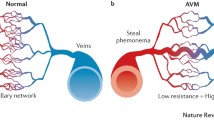Summary
Background. The present study was conducted to establish an animal model for the investigation of the pathophysiology and haemodynamics of cerebral arteriovenous malformation (AVM) but also to assess therapeutic aspects.
Method. For anatomic and haemodynamic reasons, dogs were chosen as the animal model. An arteriovenous fistula was created by interposing a segment of the superficial temporal artery between one of the main branches of the middle cerebral artery and the dorsal sagittal sinus. A temporal muscle graft supplied by this artery was implanted intracerebrally in the ischaemic area.
Findings. The angiographic and histopathologic findings obtained in the animal model are comparable with the situation found in intracerebral AVM in humans.
Interpretation. The animal model of intracerebral AVM established in this study allows for further investigation of the pathophysiology and dynamics of this disorder. It may help to develop better therapeutic options and thus improve the prognosis of affected patients.
Similar content being viewed by others
Author information
Authors and Affiliations
Rights and permissions
About this article
Cite this article
Pietilä, T., Zabramski, J., Thèllier-Janko, A. et al. Animal Model for Cerebral Arteriovenous Malformation. Acta Neurochir (Wien) 142, 1231–1240 (2000). https://doi.org/10.1007/s007010070019
Issue Date:
DOI: https://doi.org/10.1007/s007010070019




